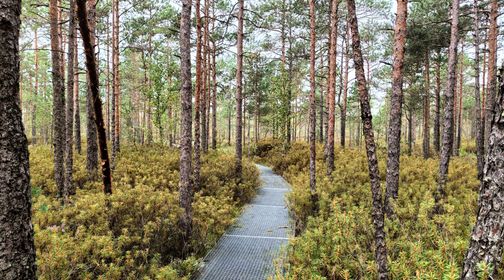
The reserve covers an area of 400 square kilometers in the Karšuva Forest, situated in the lowlands of Karšuva, formed during the glacial retreat. At that time, it was surrounded by a shallow pre-glacial basin and covered with ancient sediments of the Nemunas Delta - sands. After the glacial period, lower areas were flooded, while wind-formed sand dunes formed in drier areas. Adjacent to the reserve is the Kaskalnis Geomorphological Sanctuary, preserving the highest inland dunes in Lithuania.
Peat bogs occupy about 60% of the reserve area. Artoji, also known as the Great Peatland, is a complex 1072-hectare peat massif, with the majority being raised bogs, although there are significant areas of transitional and lowland bogs. The average thickness of Artoji's peat layer is 3.6 meters, reaching a maximum of 9.8 meters. In some places, beneath the peat, there is a layer of up to 4 meters of sapropel. In the eastern part of the reserve, there is the 455-hectare Gličio bog with the largest Gličio Lake in the reserve covering 19 hectares. Two small raised bogs, 43 and 57 hectares in size, are located to the southwest of the reserve near the Sakalinė village.
The main "axis" of the Viešvilė Reserve is the Viešvilė River (length 21.4 km, flowing through the reserve for 15 km). It is one of the most natural, unregulated rivers, with almost its entire basin spread over wooded areas. The source of Viešvilė is the 6-hectare Buveinių Lake, situated in the north of Artoji. In the upper reaches, it meanders slowly through bogs for 6.5 km. In the middle reaches, supplemented by numerous springs, it crosses a sandy plain covered with dunes. Unfortunately, just beyond the reserve's borders, two dams have been built, disrupting the natural flow and blocking the passage for migrating fish.
The bogs boast a great diversity of types, including open and forested raised bogs, transitional bogs, and lowland bogs. Dominant forest types in the bogs include Scots pine forests (in raised bogs), spruce and pine forests, and birch forests (in lowland bogs). In the past, the bogs were not drained, preserving their originality. Many rare plants still survive here, such as Saxifraga hirculus, Liparis loeselii, and Collarorhiza trifida, found in open and semi-open transitional bogs. Along the edges of the raised bogs, in old spruce and pine forests, many endangered species of fungi, mosses, and lichens find excellent shelter. Many of them are rare throughout Europe and were first discovered in Lithuania.
A unique feature of the Viešvilė Reserve is the mosaic-like complexity of the entire natural complex. Even within a short distance, you can see a wide range of various bogs, forests, water bodies, meadows, and clearings.
Rare beetle species typical of ancient forests are found in the forests (such as Ceruchus chrysomelinus and Gnorimus variabilis). The Viešvilė River is home to brown trout (Salmo truta fario), brook lamprey (Lampetra planeri), and abundant common bullheads (Cottus gobio).
In the forests, you can encounter various woodpeckers (Picus canus, Dendrocopos leucotos), and birds of prey (Aquila pomarina, Aegolius funereus). The bogs are home to a large population of cranes (Grus grus), with permanent habitats for Northern lapwings (Pluvialis apricaria). During autumn and spring, flocks of migrating birds settle in the boggy lakes. In the dense forests surrounding the raised bogs, large predators such as wolves (Canis lupus) and lynxes (Lynx lynx) hide. The Viešvilė River is home to numerous beaver (Castor fiber) dams, and otters (Lutra lutra) inhabit its waters.


